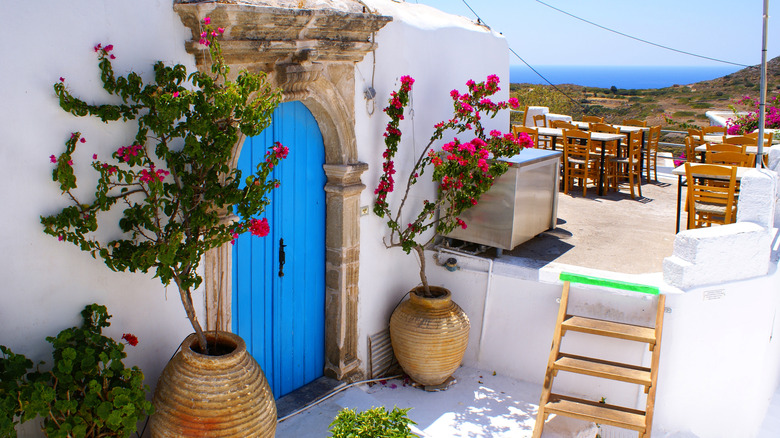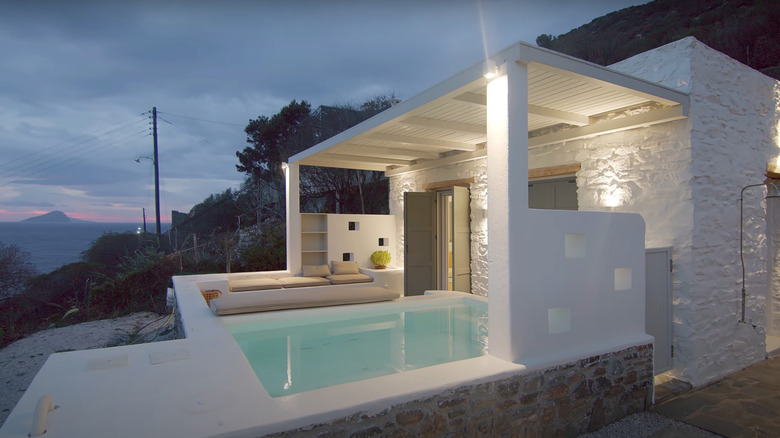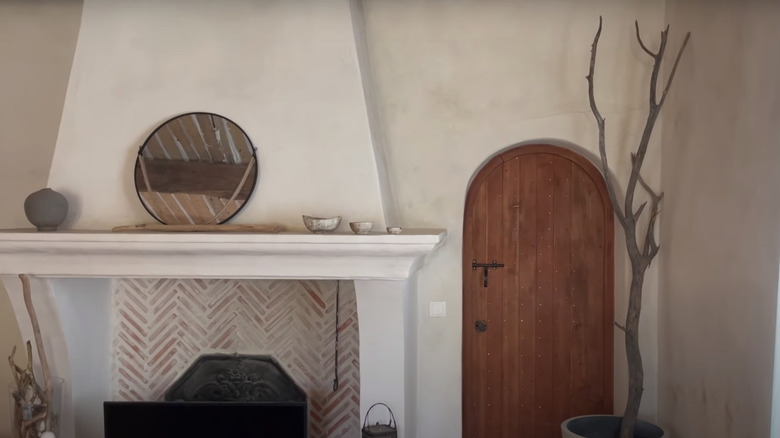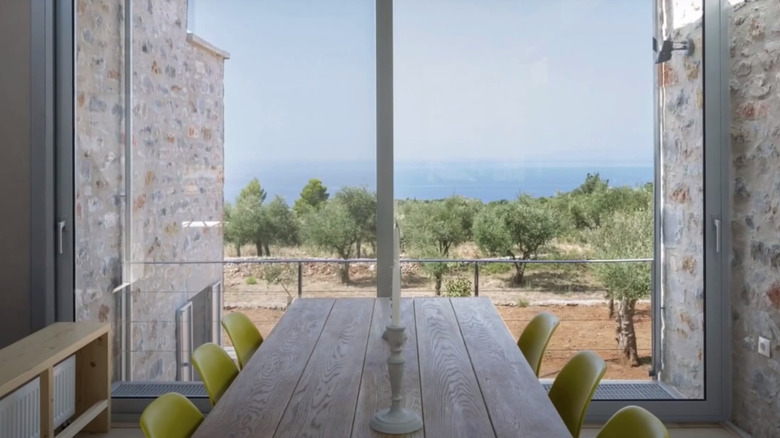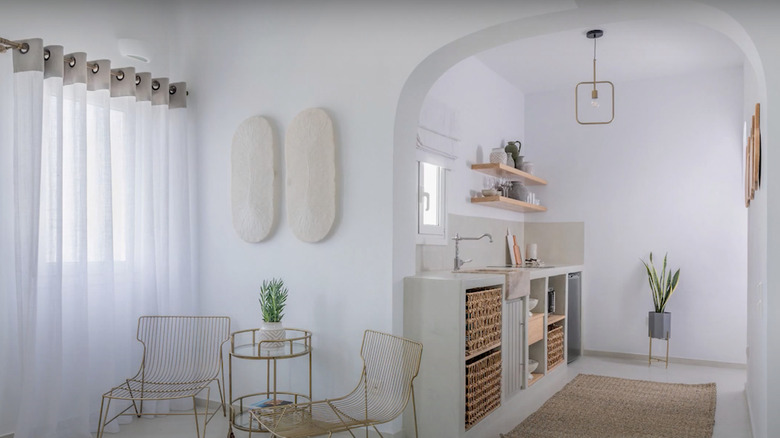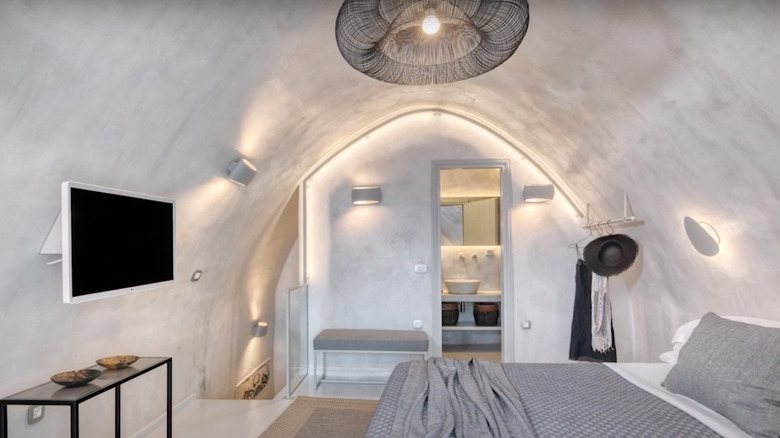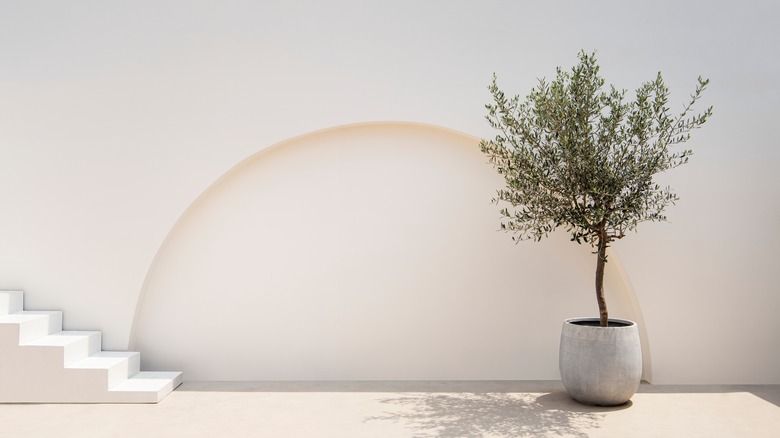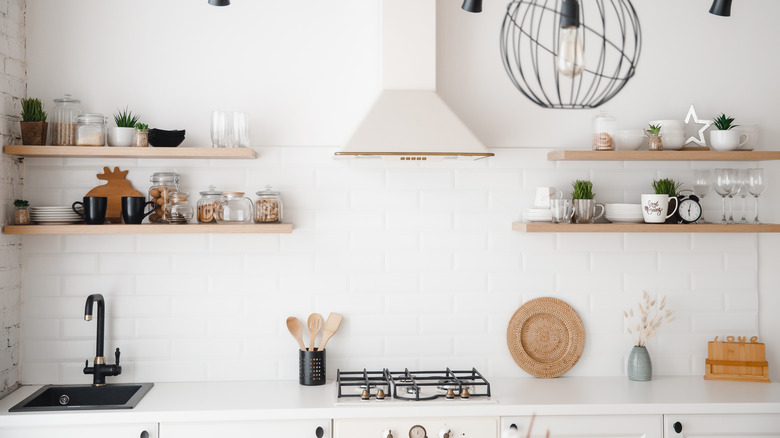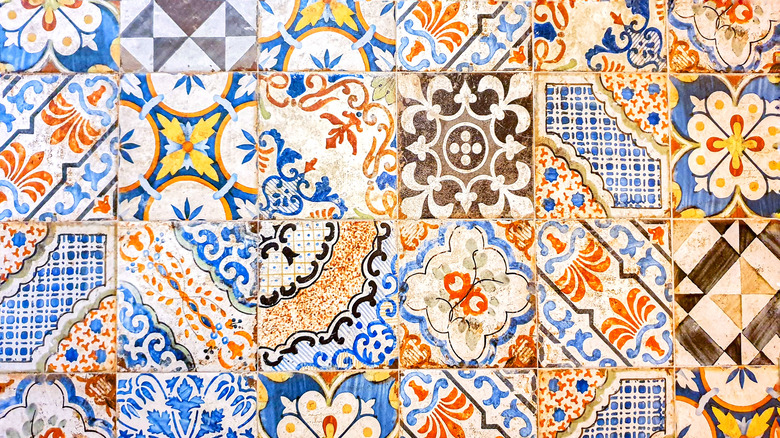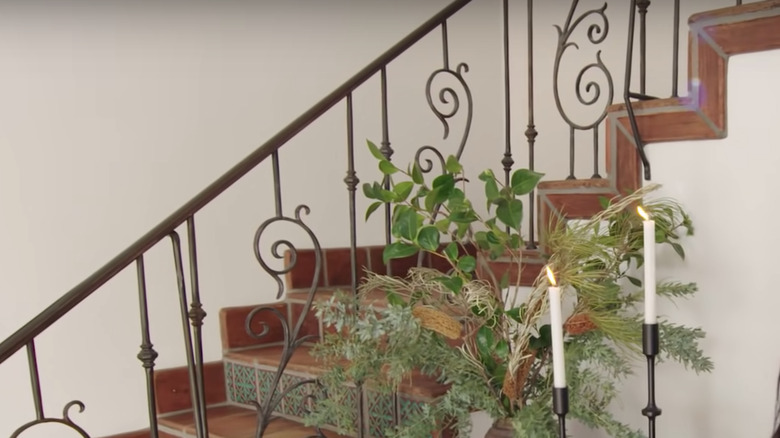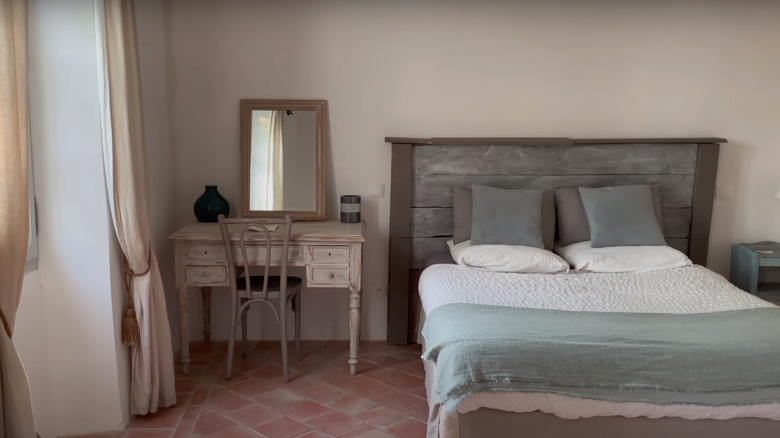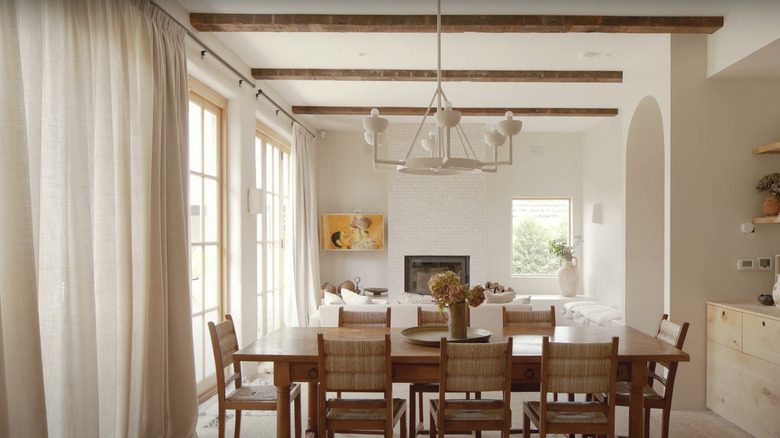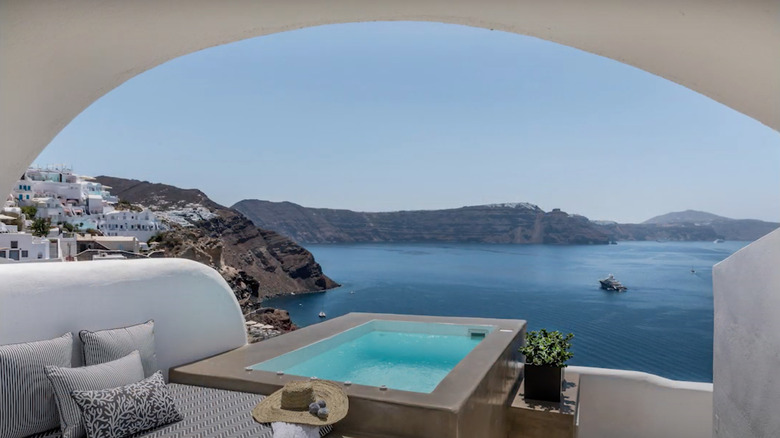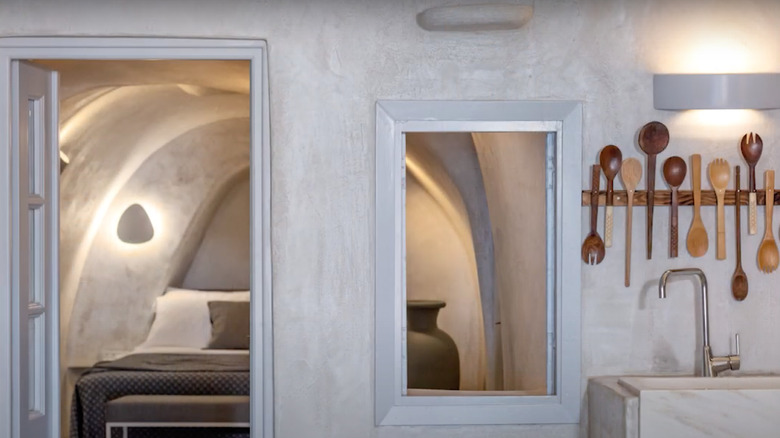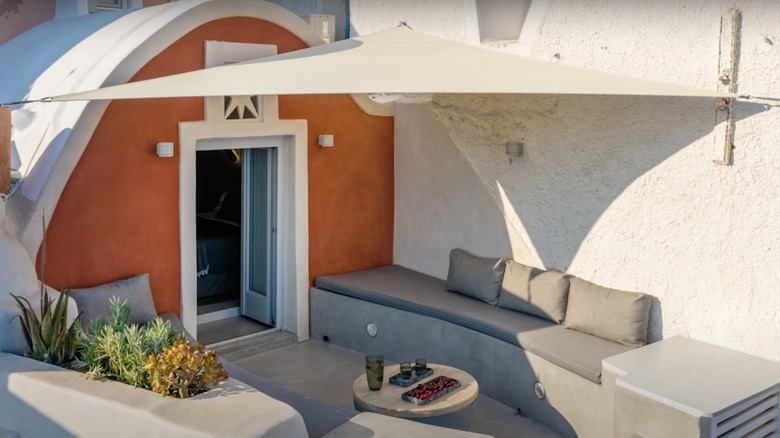How To Decorate Your Home With Mediterranean Style
The Mediterranean is the ultimate idyllic escape, known for magical sunsets and stunning blue seas and skies. While generally used to refer to countries like Greece, Italy, and Spain, the Mediterranean region is actually large and diverse, spanning from southern Europe to northern Africa and western Asia, as reported by Architectural Digest. The 21 countries that border the Mediterranean Sea all have a unique heritage and their own traditional aesthetic. Still, some key themes define Mediterranean design as a whole, such as a sense of warmth, history, and an effortless, laid-back style.
If you've been dreaming of breezy seaside living along the Mediterranean Sea, why not bring a taste of this chic style into your home? Model your home after the Med by incorporating natural materials, encouraging indoor-outdoor living, bringing in plenty of light, and using a rustic, minimalist approach (via Elle Decor). Even if you don't have a sparkling ocean view or live in a warm and sunny climate, you can still transform your living space into a Mediterranean oasis with these simple interior design tips.
Blur the boundary between indoor and outdoor living
Mediterranean living naturally blends indoor and outdoor spaces, from watching sunsets on the terrace to stargazing in the backyard pool. While it might feel normal to view the inside of your home as separate from a balcony or backyard, Med-style is all about linking the two spaces together and making them feel cohesive, as reported by The Spruce. Plus, decorating your outdoor spaces creates a more spacious feeling in your home and helps you enjoy plenty of sunlight and fresh air (via Real Homes).
To pull off this trick, decorate your outdoor patio, balcony, or terrace with the same aesthetic inside your home. This can include painting fences or outdoor walls the same color as inside your home, or using the same type of flooring in both areas to naturally blur the line between the interior and exterior. Just be sure to opt for weather-resistant flooring like tile.
Incorporate lots of natural materials
Natural materials are a staple of Mediterranean households. According to Alexandra Studio, you'll often find stone, terra cotta, wood, and fabrics like cotton or linen in a typical Mediterranean home, whether used for finishes or decoration. Natural elements like old stone walls preserve a home's rich history and character while also adding texture and visual interest.
However, you definitely don't have to live in a historic villa to incorporate natural materials in your home. By simply layering natural decorative objects in a room, you can give any living space a Mediterranean makeover. Items like jute rugs, ceramic lamps, woven baskets, rattan chairs, and wooden coffee tables instantly make rooms feel more organic and refined (via Modsy). And if you're sprucing up an outdoor space, stone benches and jute pendant lamps are both great ideas. Made from dried plants, jute is an extremely popular natural material for home decor due to its durability and versatility (via MyDomaine).
Let there be light
As the majority of Mediterranean countries have warm and sunny climates, this interior design style tends to emphasize natural light. According to Foyr, natural light is central to the Mediterranean aesthetic, and these homes typically make the most of light by incorporating large windows, sheer curtains, or skylights. Bringing more light into your home not only makes it look brighter and more spacious, but can also boost your mood (via House Beautiful).
If you want to draw some inspiration from Mediterranean interior design and lighten up your living space, start by giving your windows a thorough cleaning. Removing layers of dust and grime will instantly increase light levels. Instead of using dark curtains or blinds for window treatments, opt for sheer curtains to bring more light inside (via Apartment Therapy). And if you have the time and budget to take on a larger remodeling project, consider installing large windows and doors to maximize light.
Add arches to your home
Elegant archways are synonymous with Mediterranean-style homes. According to Elle Decor, they often appear around windows, porches, and doors for ornamental and structural reasons. Even the most simple arches lend a romantic, effortless appeal to a home. This architectural element is especially common in Italian Renaissance-style dwellings from the 15th and 16th centuries (via Broke and Chic).
If you wish to capture the essence of Mediterranean style, elevate your space with arches. This feature has the power to make any room feel larger and more open since it draws the eye upwards to take in the full height of the wall (via Livingetc). If you are lucky enough to already have arches in your home, make them pop by painting the arch in a color that contrasts with the surrounding wall, adding wallpaper around the arch, or hanging up a beautiful curtain. But don't worry if you don't have an arch. You can always have this architectural feature added (via This Old House). You can also get this look by painting an arch on a wall or incorporating a curved mirror or bookshelf.
Minimalism is key
Mediterranean style is all about embracing minimalism. As reported by Elle Decor, Mediterranean homes use a "less is more" approach when it comes to decorating. Forget wild patterns, bold artwork, and color schemes — this southern aesthetic typically features neutral color palettes, clean lines, and natural textures like wood to make one feel at home in warm and simple interiors.
To make your interiors feel more minimalist, cut back on clutter. While keeping our living spaces free of clutter is not always easy, neat and clean surfaces instantly make a room feel airier (via Apartment Therapy). Even if you have hoarder tendencies, you can become more minimalist by focusing on functionality and quality over quantity. When it comes to accessorizing, look for pieces with muted colors that won't overwhelm larger furniture pieces like a couch or table. It also helps to invest in chic storage spaces so that you can easily keep the clutter behind closed doors (via MyDomaine).
Look for Mediterranean-style greenery
Whether it's bougainvillea vines trailing along a wall or potted olive and lemon trees on a porch, Mediterranean greenery evokes the feeling of summer in any space. Gardenia reported that Mediterranean gardens are low-maintenance, showcase subtle colors, utilize trimmed hedges, and decorate with gravel paths. They tend to have an effortless, laid-back feel to encourage al fresco dinners and sunny afternoon naps.
While the Med is known for its beautiful gardens, lush plants, and vibrant flowers, you don't need to live in Greece or Italy to get the look of a Mediterranean garden at home. You can make your outdoor space feel like a European villa by sprucing it up with a pergola, terra cotta pots, water fountains, and mosaics. Many plants used in Med-style gardens are tolerant to drought, dry soil, and hot weather conditions. Incorporate citrus trees for lively greenery and bright color, or opt for a classic olive or cypress tree. The best zones for Med plants are 8 to 11, so if you live in a colder climate, choose species resistant to frost or transport plants to a greenhouse for the winter (via Garden Design).
Show off ceramic bowls and dishware with open shelving
Add some Mediterranean flair to your home with open shelving in the kitchen or living room. According to The Spruce, these Mediterranean-style shelves are ideal for showing off pretty dishware, ceramics, and other rustic accessories. It will add warmth and a touch of coziness to the room. While open shelving can be controversial since it can make spaces appear more cluttered, the style certainly has many fans, including celebrities like Drew Barrymore, Tamera Mowry, and Reese Witherspoon (via The Zoe Report). Plus, it's easy and budget-friendly to install your own shelves (via Willow Bloom Home).
If you're wondering what to display on open shelves to give them a Mediterranean feel, mix rustic ceramic pieces with houseplants and small decorative items like candles or vases. Place items you regularly use on lower shelves for easy access, and put fancier pieces and accessories on higher shelves (via Better Homes and Gardens).
Create interest with mosaic tiles
Intricate mosaic tiles are a hallmark of the Mediterranean, from Morocco to Albania and beyond. According to Home Flooring Pros, there are many different tile styles from this region, including Roman-style tile patterns, hexagonal terra cotta, curvy Moroccan-style, and black-and-white checkerboard floors. There's also the popular encaustic tile, which dates back to medieval times. These eye-catching tiles are made of two to six different colors of clay or cement, and come in endless patterns and colors (via House Beautiful).
If you are thinking about incorporating mosaic tiles within your home, the sky is the limit! Add a bold pattern to your kitchen backsplash or put a subtle mosaic tile floor in your bathroom. Mosaic tiles are available in glass, ceramic, and porcelain material, and can be added in a single color or used to create highly elaborate patterns. While these tiles used to be painstakingly installed one by one, nowadays, sheets of pre-attached tiles are used to speed up the process (via The Spruce).
Bring in ornate furnishings and wrought iron details
If you've spent time in the Mediterranean, then you're probably familiar with the sight of wrought iron. From staircases to balconies, this element is practically everywhere. According to The Spruce, wrought iron brings a touch of decor to a space and is commonly used in home exteriors, particularly in gardens, patios, and terraces. It's also seen in indoor areas for fixtures and shelves. The metal is characterized by its tensile strength and malleability, since it can be repeatedly heated and molded into different shapes (via Machine Design).
If you have wrought iron in your living space, you've probably noticed that the texture attracts dust and other grime. To keep it clean, regularly vacuum surfaces with a brush before wiping surfaces with soap and water. If the paint layer has chipped, you'll want to remove loose paint with a scraper and a wire brush attached to a drill (via The Spruce). Don't wait long to repaint surfaces since exposed iron will get rusty quickly.
Use a color palette inspired by nature
From sea to sun, Mediterranean color palettes often evoke the great outdoors. According to SFGate, neutral colors like whites and grays are the norm in Mediterranean homes and are usually complemented by warm reds and browns reminiscent of natural materials. While Spanish color palettes tend to be simple with all-whites and neutrals, certain Mediterranean hotspots like Santorini layer vibrant shades of blue to mirror the sparkling blue sea and sky.
To create your own Mediterranean-inspired neutral color palette, don't limit yourself to shades of beige. Explore different pairings between light and dark neutrals, like a warm, deep brown with a light tan. You can also experiment by adding accent colors against a neutral backdrop (via The Spruce). White walls and furnishings pair well with some splashes of color. Maybe add some blue throw pillows, bright yellow curtains, or green tile work in the bathroom to liven things up.
Achieve easy, breezy Mediterranean style with exposed beams
Beloved for the character they bring to any space, exposed beams are like the cherry on top of a well-designed room. According to HGTV, it's rare to stumble upon a Mediterranean home without this rustic architectural detail. In the past, these purely functional beams were designed to hold the weight of roofs or upper levels. As construction technology improved over the years, beams were concealed under ceilings to lower heating costs (via Bob Vila). Whether left in their natural state or painted over, exposed beams make a striking addition to any living space.
If you're dreaming of coming home to exposed ceiling beams, you can make get the look by installing DIY fake wood beams (via The Spruce). These beams are empty boxes with three sides attached to the ceiling with a hidden cleat. Once you've constructed the beams, age the wood with distressing tools to get an old-world look.
Highlight the view
It's not hard to see why homes in the Mediterranean region are often designed to emphasize the view. Overlooking some of the world's bluest waters and breathtaking sunsets, Mediterranean seaside abodes naturally let their beautiful surroundings take center stage. But you don't have to live by the sea to make the most of your view.
According to Mansion Global, views of mountains, city skylines, or peaceful greenery can be emphasized with a few simple tricks. Floor-to-ceiling windows are a great way to highlight your view, along with arranging furniture so that as much seating as possible faces outside. Place mirrors next to windows or dim lighting at night to draw attention outside. If you have a room with no windows, you can also hang up some nature-inspired artwork. Be careful not to make your interior spaces too busy with patterns and colors, or else they could overwhelm your view.
Add texture to your walls
Textured, stucco walls are a traditional element of Mediterranean design. According to Better Homes and Gardens, these thick walls block out heat and keep homes cool during the day. The mottled texture of this cement-based plaster is characteristic of homes in the Mediterranean.
You can easily add a textured look to your walls by whitewashing or using a faux painting technique (via SFGate). Start by preparing the area by removing any furniture or covering it with protective cloths. Apply painter's tape and thoroughly clean surfaces where you'll be painting. If you would like a more transparent whitewash, blend 1 part latex paint with 3 parts water, or opt for a thicker wash by using equal amounts of latex and water. Before diving into the painting process, test out a small wall patch and see how it looks. From there, you'll apply the paint in small sections and use a cloth to buff the paint as you go. The great thing about this technique is that imperfection is part of the charm.
Create warm, inviting spaces for entertaining
Along with sun and sea, the Mediterranean is a place to soak up plenty of warm hospitality. According to The Spruce, a key element for Med homes is having space for entertaining family and other guests. Particular attention is paid to seating areas in common rooms, both in and outdoors, and there's often a large dining room table for enjoying meals together.
To make your home fit for hosting visitors, add plenty of seating options to your living area and stock up on cozy cushions and couches. Conversation flows best when seats are less than 10 feet apart but not so close together that people run into each other (via Houzz). It's also a good idea to incorporate side tables where guests can easily set down their drinks or snacks. If you have an outside area, set up a fire pit or outdoor table with a canopy over it to enjoy meals al fresco.
